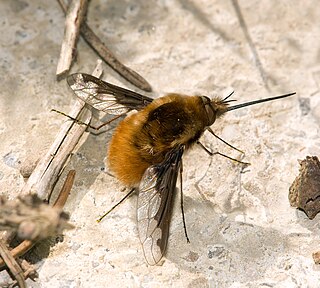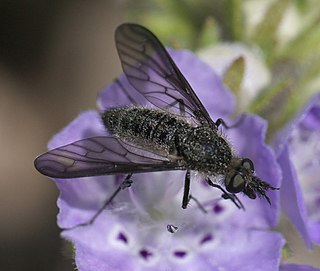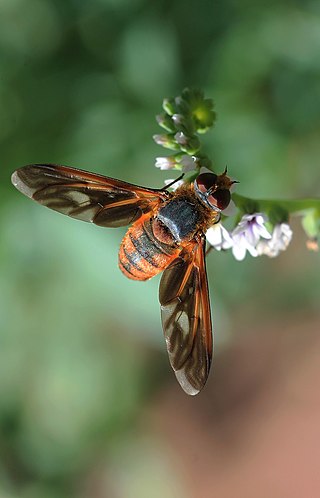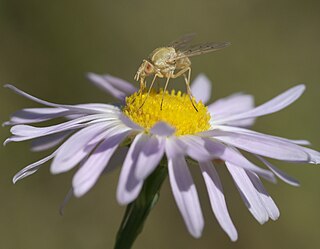
The Bombyliidae are a family of flies, commonly known as bee flies. Some are colloquially known as bomber flies. Adults generally feed on nectar and pollen, some being important pollinators. Larvae are mostly parasitoids of other insects.
Paravilla is a genus of bee flies in the family Bombyliidae. There are at least 50 described species in Paravilla. The genus is found in North and South America.

Bombyliinae is a subfamily of bee flies in the family Bombyliidae. There are more than 70 genera in Bombyliinae.

Poecilanthrax effrenus is a species of bee fly in the family Bombyliidae.

Lordotus is a North American genus of bee flies in the family Bombyliidae. There are about 30 described species in Lordotus.

Lepidophora is a genus of bee flies in the family Bombyliidae. There are eight described species in Lepidophora.

Eclimini is a tribe of bee flies in the family Bombyliidae. This tribe was formerly considered a subfamily of Bombyliidae, but was transferred to the subfamily Bombyliinae as a result of research published in 2019.
Poecilognathus punctipennis is a species of bee fly in the family Bombyliidae. It is found in Florida and Georgia.

Poecilognathus is a North and South American genus of bee flies in the family Bombyliidae. There are about 13 described species in Poecilognathus.
Lepidophora vetusta is a species of bee fly in the family Bombyliidae. It is found in Texas, Mexico, and Central America as far south as Costa Rica.

Geron vitripennis is a species of bee fly in the family Bombyliidae. It is found across most of the United States, north into Ontario, and south into Mexico.

Geron is a genus of bee flies in the family Bombyliidae. There are at least 180 described species in the genus Geron, found on every continent except Antarctica.
Xenox delila is a species of bee fly in the family Bombyliidae. It is found in California and Baja California Norte.

Anastoechus hessei is a species of bee fly in the family Bombyliidae. It is found in the southwestern United States from California to Texas. Its larvae are predators of grasshopper eggs.
Paracosmus edwardsii is a species of bee fly in the family Bombyliidae. It is known from California and Utah.
Xenox xylocopae is a species of bee fly in the family Bombyliidae. It is found in Mexico, Arizona, Texas, and New Mexico.
Lepidanthrax oribates is a species of bee fly in the family Bombyliidae. It is widespread in the western United States from California and Nevada north to British Columbia, Canada.
Rhynchanthrax capreus is a species of bee fly in the family Bombyliidae. It is found in Mexico and the southwestern United States from California to Nebraska.

Dipalta serpentina is a species of bee fly in the family Bombyliidae. It is widespread in North America from British Columbia, Canada south and east through most of the United States to Florida, Mexico, Cuba, Guatemala, and Honduras. It is a parasitoid of antlion species such as Myrmeleon immaculatus.

Lepidophora lepidocera, the scaly bee fly, is a species of bee fly in the family of Bombyliidae. It is found in the eastern United States from Florida and New York west to Texas and Colorado.











